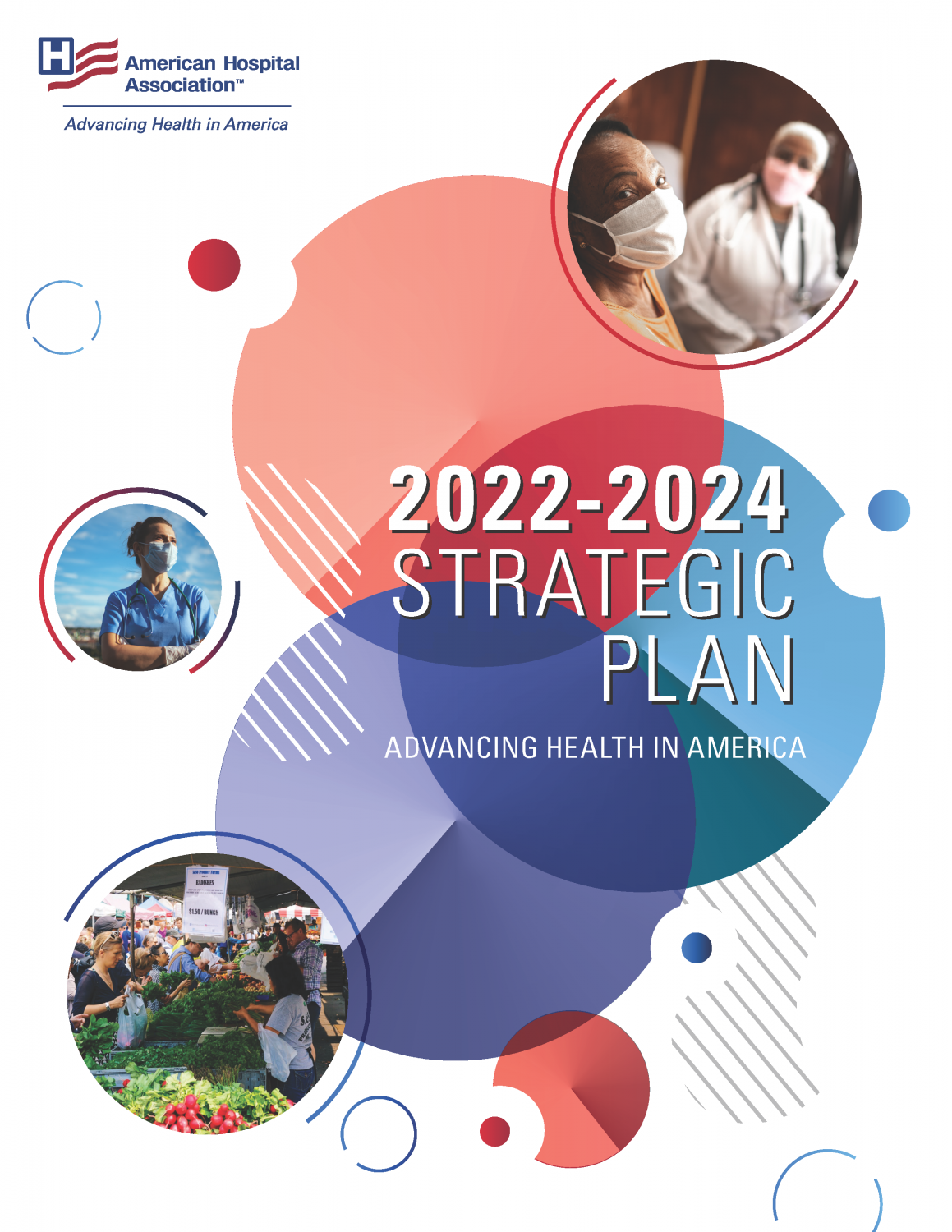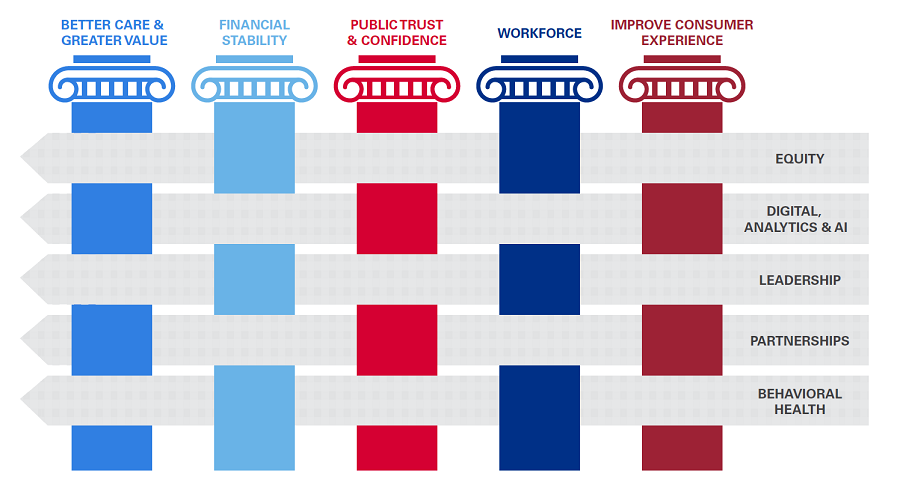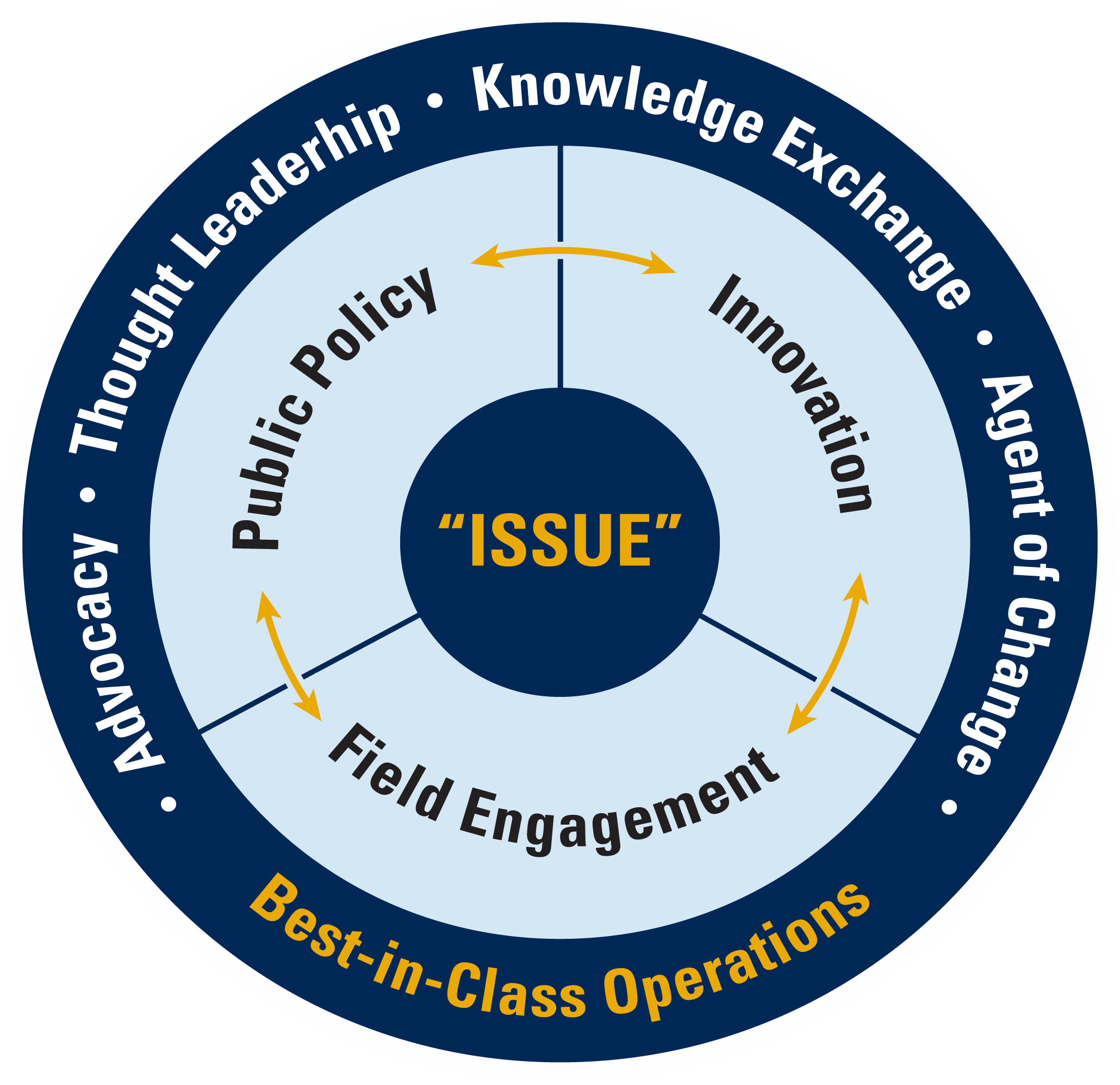

AHA's 2022–2024 Strategic Plan
A Message from the AHA
“To reach a port, we must sail—sail, not tie at anchor—sail, not drift.” Franklin D. Roosevelt
Since America’s first hospital opened its doors in 1751, caregivers have never stopped working to improve quality, safety and the patient care experience.
That’s why in 2022, the AHA developed a strategic plan that we believe will keep this unshakeable commitment to progress alive and move us closer to achieving our vision of a just society of healthy communities, where all individuals reach their highest potential for health.
AHA’s 2022-2024 Strategic Plan includes five strategic objectives or pillars that will guide the association’s work as we advance health in America. These include:
- Provide Better Care and Greater Value
- Ensure the Financial Stability of Hospitals and Health Systems
- Enhance Public Trust and Confidence in Hospitals and Health Systems
- Address Workforce Challenges: Now, Near and Far
- Improve the Health Care Consumer Experience
Our plan also acknowledges that equity and behavioral health cut across each of these goals and that advanced data analytics, leadership and partnerships will be pivotal to achieving success.
In 2024, we face many challenges such as workforce shortages, inflation, government underpayments and more. These challenges are serious but not insurmountable.
At the same time, we also see much promise for the future through the use of technology, medical breakthroughs and innovation. We hope that AHA’s Strategic Plan will be useful to you as we chart a course to 2025 and provides a framework that you can use as your own organization navigates through this challenging environment.
The AHA is incredibly proud to stand with you and support you. Together, we can remain cornerstones of our communities and continue to deliver the compassionate care that so many generations of Americans have counted on — and continue to count on today.

Joanne M. Conroy, M.D.
CEO and President
Dartmouth Health
2024 AHA Chair

Rick Pollack
President and CEO
American Hospital Association
Environmental Factors
- Workforce challenges have been exacerbated by the pandemic and are expected to be a leading focus into future years. These challenges include resilience and emotional health for the existing workforce and significant shortages for many segments of the health care workforce.
- Ongoing disproportionate impact of the pandemic on structurally or historically marginalized communities is further exacerbating the divide of health outcomes.
- Affordability concerns continue to influence individual consumers, employer payers and policymakers.
- The need to increase coordination and integration of behavioral health with physical health improvement is amplified as a result of the country’s experience with COVID-19.
- The effectiveness of value-based payment models as a way to reduce costs are under scrutiny as overall health care costs continue to rise.
- The impact of rising inflation will create additional strain on an already financially-fragile health care delivery system.
- Mid-term elections in 2022 will further increase political partisanship in Washington, D.C.





AHA’S Strategic Plan
2022-2024
AHA’s Strategic Plan sets forth five strategic objectives or pillars that will guide the association’s work as we advance health in America. With input and direction from the AHA Board of Trustees, the framework includes an ambitious set of goals:
- Provide Better Care and Greater Value
- Ensure the Financial Stability of Hospitals and Health Systems
- Enhance Public Trust and Confidence in Hospitals and Health Systems
- Address Workforce Challenges: Now, Near and Far
- Improve the Health Care Consumer Experience
The illustration below shows how key priorities such as equity and behavioral health — issues which COVID-19 brought to the forefront in new ways — crosscut throughout each of these strategic goals. It also highlights how advanced data analytics, leadership and partnerships are necessary ingredients to make progress on the key strategies of the plan.
Each pillar will have a signature effort and strategies that will involve both the public policy arena as well as field leadership. The strategic plan will be backed by operational goals and plans that will guide our work and priorities.

Our Pillars and Goals
Better Care and Greater Value
Signature Effort: Form and operate an alliance to pursue the longer-term goals
- Advance value-based care models
- Integrate equity metrics and targets in all care analytics
- Optimize care flexibility in site of care
- Accelerate the adoption of precision medicine and application of artificial intelligence/advancing technologies
- Transform chronic/complex disease and end-of-life care
Ensure the Financial Stability of Hospitals and Health Systems
Signature Effort: Further the six-prong approach defined in 2021 primary care capitation, national/regional provider network, holding insurers accountable for their harmful behaviors, rural health care alternatives, urban metropolitan anchor hospital, and behavioral health/psychiatry.
- Address inefficiencies in intersection of acute care to the U.S. public health care system
- Protect rural health capacity
- Assess the future of academic medical centers
- Create and execute a sustainability agenda
- Restructure the supply chain on a national and regional level
Enhance Public Trust and Confidence in Hospitals and Health Systems
Signature Effort: Execute Seizing the Conversation strategy
- Amplify the positives and counteract the negatives
- Produce scholarship in support of strategy
- Promote health literacy
- Address social media misinformation
- Combat erosion of trust in science
Address Workforce Challenges: Now, Near and Far
Signature Effort: Identify and pursue, with partners, three breakthrough efforts to address now, near and far challenges
- Enact a multi-pronged effort to address workforce supply
- Advance and accelerate new care models for inpatient and ambulatory settings
- Introduce and improve resilience capacity
- Reskill current workforce
- Maintain regulatory reforms gained during the pandemic
Improve the Health Care Consumer Experience
Signature Effort: Define the ideal health care consumer experience by consumer segment
- Establish consumerism metrics, including baseline and targets for improvement
- Enhance rapid digitization of business and clinical processes
- Curate best-in-class digital practices and provide resources to scale
- Improve business and clinical analytic capabilities
- Prepare for the next public health emergency and define our role in response
Our Approach
Advocacy and Member Solutions
Advocacy Strategy
AHA advocacy efforts center on positively influencing the public policy environment for patients, communities and the health care field. The AHA advances key issues through a variety of advocacy strategies such as:
- Grassroots efforts through the mobilization of millions of individual supporters
- ‘Grass-tops’ action to amplify our voice through key media and stakeholders
- Sustained engagement with top policymakers
- Legal advocacy to protect and support hospitals, patients and communities in the courts
- Data-driven research regarding the impact of potential policy changes
- Telling the hospital story and focused advertising through a variety of media
- Provide leadership to the Coalition to Protect America’s Health Care to ensure that hospitals and health systems have the resources necessary to provide access to high quality care.
The AHA Provides Value, Guidance and Foresight Through:

We Are AHA
Regardless of how the “H” is defined, the AHA represents all types of hospitals and health systems by aligning public policy, membership engagement and field leadership to cohesively address issues important to members. Our best-in-class operations will strengthen efficiency and effectiveness, and amplify progress on priority issues.

The AHA is the trusted partner of hospitals and health systems and stands ready to work in collaboration to advance health in America. Visit www.aha.org for more.


